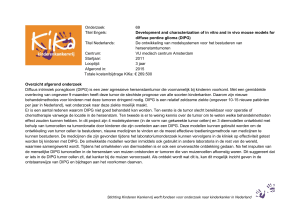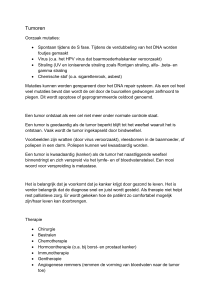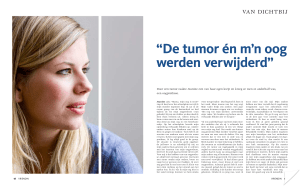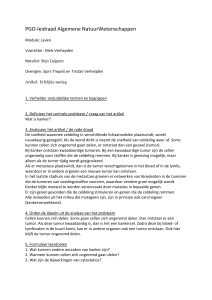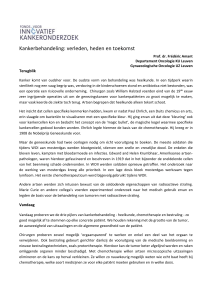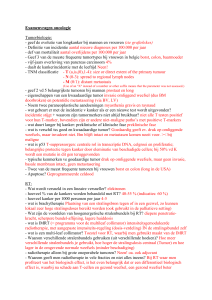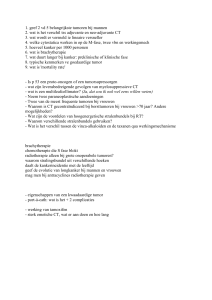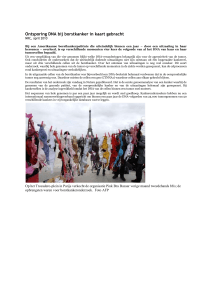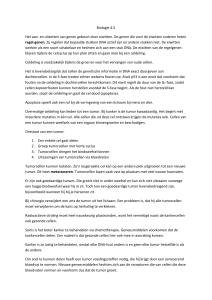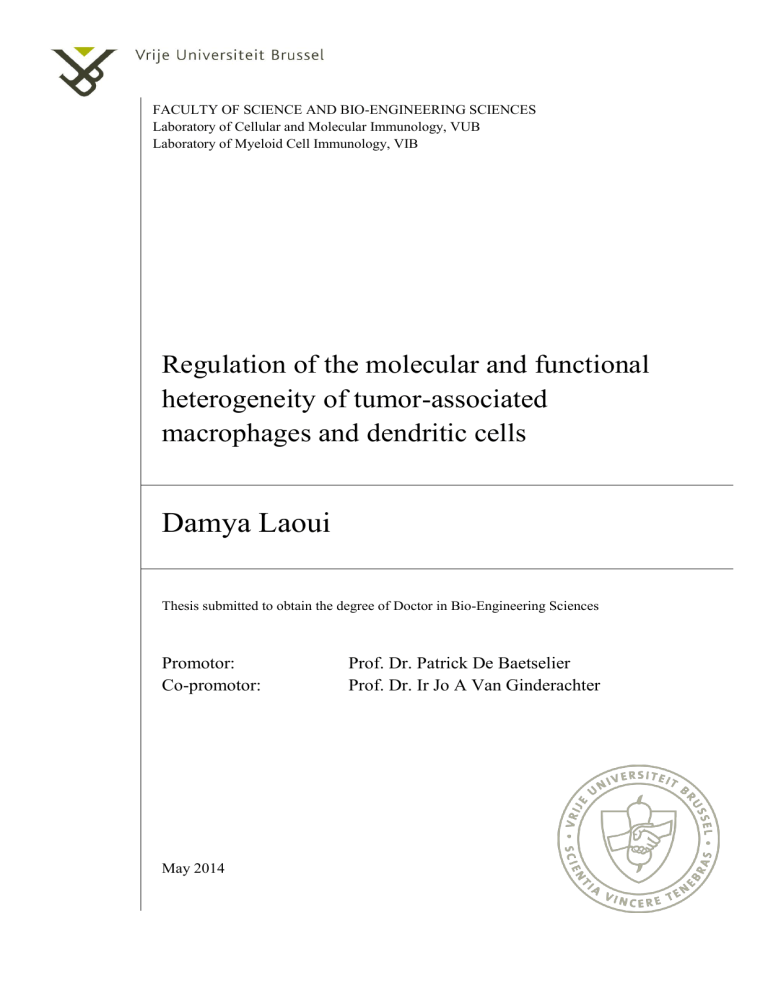
FACULTY OF SCIENCE AND BIO-ENGINEERING SCIENCES
Laboratory of Cellular and Molecular Immunology, VUB
Laboratory of Myeloid Cell Immunology, VIB
Regulation of the molecular and functional
heterogeneity of tumor-associated
macrophages and dendritic cells
Damya Laoui
Thesis submitted to obtain the degree of Doctor in Bio-Engineering Sciences
Promotor:
Co-promotor:
May 2014
Prof. Dr. Patrick De Baetselier
Prof. Dr. Ir Jo A Van Ginderachter
Summary
Tumors consist not only of neoplastic cells, but should be considered as organ-like
structures in which a complex bidirectional interplay exists between transformed cells
and the surrounding stroma. Myeloid cells form an important component of the tumor
stroma and are characterized by an extreme heterogeneity and plasticity with partially
overlapping molecular and functional phenotypes. They are often abundantly present
in the tumor microenvironment and are implicated in a wide array of pro-tumoral
functions. Hence, this PhD thesis aimed to thoroughly characterize the myeloid cells
present in the tumor microenvironment at a molecular and functional level, with a
focus on tumor-associated macrophages (TAM) and tumor-associated dendritic cell
(TADC) heterogeneity and the role of hypoxia in skewing the TAM phenotype.
TAM are exposed to multiple microenvironmental cues in tumors, which collaborate
to endow these cells with protumoral activities. Hypoxia, caused by an imbalance in
oxygen supply and demand due to a poorly organized vasculature, is often a
prominent feature in solid tumors and could thus possibly regulates the TAM
phenotype in vivo. In this work, we show that the myeloid infiltrate in mouse lung
carcinoma tumors encompasses two morphologically distinct TAM subsets,
designated as MHC-IIlo and MHC-IIhi TAM, both of which were derived from tumorinfiltrating Ly6Chi monocytes. MHC-IIlo TAM express higher levels of prototypical
M2 markers, such as macrophage mannose receptor (MMR), and reside in more
hypoxic regions and contain consequently higher levels for hypoxia-regulated genes
than their MHC-IIhi counterparts.
When growing better oxygenated tumors in PHD2+/- mice, reduced tumor hypoxia did
not alter the relative abundance of TAM subsets nor their M2 marker expression, but
lowers hypoxia-sensitive gene expression and angiogenic activity specifically and
solely in the hypoxic in MHC-IIlo TAM. Hence, hypoxia is not a major driver of
TAM subset differentiation, but rather specifically fine-tunes the phenotype of M2like MHC-IIlo TAM.
To visualize and target these hypoxic MMR+ MHC-IIlo TAM, we generated MMRspecific nanobodies (Nb), which are single-domain antigen-binding fragments derived
from Camelidae heavy-chain antibodies. Radioactively labeled (99mTc) labeled antiMMR Nb accumulate in intratumoral hypoxic regions and successfully target
specifically MMR+ TAM in vivo. Importantly, co-injection of excess unlabeled,
bivalent anti-MMR Nb reduce Nb accumulation in extra-tumoral organs to
background levels, without compromising tumor uptake. Thus, anti-MMR Nb can be
used to selectively target and image hypoxic M2-like TAM in vivo and form a
potentially new tool for diagnostic and therapeutic approaches.
Besides TAM, tumors contain also TADC, whose phenotype was until now only
poorly characterized. Our results denote the co-existence of three ontogenically and
functionally discrete TADC subsets in several tumor models of different histological
origins, being CD8+-like cDC, CD11b+-like cDC and Mo-DC.
In conclusion, this work brings new insights in the biology of macrophages and
dendritic cells in cancer, highlighting their molecular and functional heterogeneity
and proposing new strategies for future therapeutic interventions.
Samenvatting
Tumoren dienen beschouwd te worden als orgaanachtige structuren, waarin een
complexe bidirectionele interactie bestaat tussen getransformeerde neoplastische
cellen en de omgevende tumor stroma. Myeloide cellen maken een belangrijk deel uit
van de tumor stroma en zijn gekenmerkt door een extreme heterogeniteit en
plasticiteit met gedeeltelijke overlappende moleculaire en functionele fenotypes. Ze
zijn vaak aanwezig in grote getallen in de tumor micro-omgeving en zijn betrokken in
een brede resem aan protumorale functies. Deze doctoraatsthesis beoogt de grondige
karakterisering van myeloide cellen aanwezig in de tumor micro-omgeving op
moleculair en functioneel niveau, met specifieke focus op tumor-geassocieerde
macrofaag (TAM) en tumor-geassocieerde dendritische cel (TADC) heterogeniteit, en
op de rol van hypoxie op de ontwikkeling van het TAM profiel.
In de tumor omgeving worden TAM blootgesteld aan veelvuldige omgevingssignalen,
die TAM bewapenen met tumorpromoverende functies.
Hypoxie is een uitgesproken kenmerk van vaste tumoren, en wordt veroorzaakt door
een verstoorde vasculatuur en een onevenwicht in zuurstofbehoefte en –toevoer en
zou dus mogelijk het TAM fenotype in vivo kunnen beïnvloeden. In dit werk tonen
we aan dat het myeloid tumor infiltraat in muis longcarcinoma’s twee morfologisch
verschillende TAM subpopulaties bevat. Beiden zijn afkomstig van tumorinfiltrerende
Ly6Chi monocyten, en worden respectievelijk MHC-IIlo en MHC-IIhi TAM genoemd.
MHC-IIlaag TAM vertonen een hoge expressie van prototypische M2-geassocieerde
merkers, zoals macrofaag mannose receptor (MMR), vertoeven voornamelijk in
hypoxische tumorregio’s en drukken bijgevolg hogere niveaus aan hypoxiegereguleerde genen in vergelijking met de MHC-IIhoog TAM.
Wanneer men tumoren tot ontwikkeling laat komen in PHD2+/- muizen, een
muisgenotype met een betere tumor oxygenatie, bleven de relatieve proporties aan
TAM subpopulaties en de expressie van M2 merkers onveranderd, maar was de
expressie van hypoxie-gevoelige genen en de angiogene activiteit significant verlaagd
uitsluitend in MHC-IIlaag TAM subpopulatie. Hieruit kan besloten worden dat hypoxie
niet de drijvende kracht is achter de differentiatie van de Ly6Chi monocyten in MHCIIlaag en MHC-IIhoog TAM, maar eerder betrokken is bij het verfijnen van het fenotype
van de M2 MHC-IIlaag TAM.
Om deze hypoxische MMR+ MHC-IIlaag TAM te visualiseren en te targeten, werden
MMR-specifieke nanobodies (Nb) ontwikkeld. Nb zijn antigen-herkennende
enkeldomein antilichaam fragmenten afgeleid van antilichamen van kameelachtigen.
Radioactief gelabelde (99mTc) anti-MMR Nb associëren met hypoxische regio’s
binnen de tumor mico-omgeving en binden efficiënt en op specifieke wijze de MMR+
TAM in vivo. Bovendien kan een overmaat aan ongelabeld bivalent anti-MMR Nb de
Nb accumulatie in extra-tumorale organen reduceren zonder de Nb-binding in de
tumor te beïnvloeden. Bijgevolg kunnen anti-MMR Nb gebruikt worden voor de
selectieve in vivo beeldvorming en targeting van hypoxische M2 TAM en vormen een
potentiele nieuwe tool voor diagnostische en therapeutische doeleinden.
Naast TAM omvatten tumoren ook TADC, waarvan het fenotype tot nu toe maar
amper is beschreven. Onze resultaten tonen aan dat in verscheidene tumormodellen
met uiteenlopende histopathologische oorsprong, drie ontogenetische en functionele
verschillende TADC subpopulaties aanwezig zijn, zijnde CD8+-achtige cDC,
CD11b+-achtige cDC en Mo-DC.
Samengevat brengt dit werk nieuwe inzichten in de biologie van macrofagen en
dendritische cellen in kanker, via de identificering en moleculaire en functionele
karakterisering van de TAM en TADC heterogeniteit. Verder werd getracht deze
bevindingen te vertalen naar een therapeutische en diagnostisch setting, wat potentieel
van belang kan zijn voor toekomstige therapeutische strategieën in de strijd tegen
kanker.


